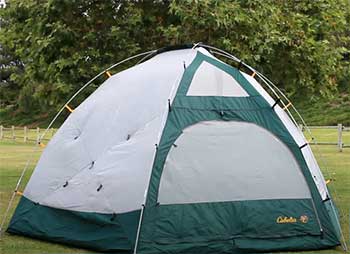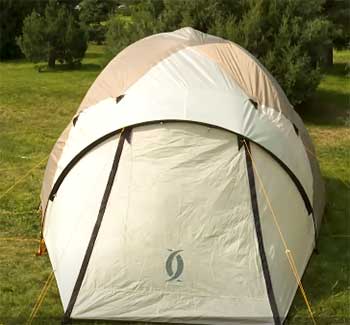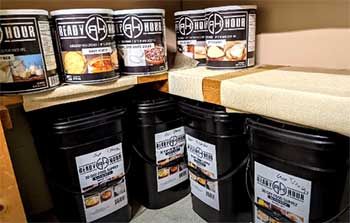Cabela’s Alaskan Guide and Cabela’s Instinct tents are very popular tents among those who love camping. But these two tents have some differences in price, material, weight, and durability.
Although tents are typically quite simple, there are a few important decisions you’ll need to make before purchasing one. These include the type of tent you want, its size, the features you value the most, etc.
If you are still confused about which Cabela tent you should buy, this article is for you. So, stick it to the end.
A Quick Comparison Table
| Specifications | Cabela’s Alaskan Guide | Cabela’s Instinct Tent |
| Weight | Heavy | Less heavy than the Alaskan Guide |
| Waterproofing | 2,000mm polyurethane waterproof coating | 3,000mm waterproof-rated polyurethane coating |
| Set-up | A bit tricky | Easy |
| Durability | Durable | More durable |
| Price | Less expensive | Expensive |
Key Differences Between Cabela’s Alaskan Guide And Instinct Tent
Let’s find out some major differentiations between these two so that you can buy the best tent for you and your family-
- Weight
“Light is right” is a phrase used frequently in the outdoor sector. That means choosing lightweight things is generally a good idea.

The use of durable yet lightweight materials is the best in the tent design.
A lighter tent is probably made of softer materials, while a heavier tent is made of stronger materials.
However, when hiking with many people, you can reduce weight by dividing the tent, rain fly, and poles.
When buying a tent, you should keep some points in mind such as – will you have to move this tent a long way?
Or, even if you have your car with you, you might carry your tent to the campsite. Can you do that by yourself?
If you can overcome these issues, then a heavy-weight tent won’t be a problem for you. Rather, you will get extra strength because of the heavy material of the tent.
Cabela’s Alaskan Guide 6-person tent weighs almost 33 lbs which is a bit more heavy-weight than Cabela’s Instinct Tent ( 27 Ibs).
Also Read: Differences Between White Duck And Kodiak Canvas Tents.
- Durability
Before making a purchase, you should always take the quality and durability of the tent material into account. The denier of the fiber is used to measure fabrics; the lower the denier, the lighter the cloth.
Cabela’s Alaskan Guide and Instinct, both have a 75-denier polyester fly with 2,000mm polyurethane coating and a 210-denier nylon floor. But a greater denier doesn’t necessarily imply a stronger cloth.
Strength is greatly influenced by thread count, which is the number of threads you can fit into a square inch. From this point of view, Instinct has a better thread count.
Actually, there are numerous ways to assess a tent’s durability. The majority of tents are composed of nylon or polyester.
Nylons are more durable but don’t hold up well in the sun; polyester tends to be weaker but stands better in UV rays.
Alaskan Guide’s wall and floor are both made of polyester, whereas Instinct’s wall is made of polyester, and the floor is made of nylon. That means Instinct Tent can protect you from UV rays as well as give extra durability to the floor.
- Tent Poles
In a storm, tent poles are very important for a tent’s resilience and strength. Composite, fiberglass, aluminum, and carbon fiber are common materials for tent poles.
Since aluminum poles offer a better weight-to-strength ratio and are less expensive than composite or carbon fiber poles, most tents are made of aluminum.
But there are some differences in aluminum also. Grade 7000 series aluminum is considered to be the best kind of aluminum.
So, before buying the tent, it would be great if you could check the quality of the aluminum also. Cabela’s Instinct use 7001 aluminum in its poles which is better than Alaska Guide’s regular aluminum pole.
- Cost Variation
You might be thinking about what you should budget for a tent. Although each of us has a different budget, it must be acknowledged that excellence is expensive.

When a cheap purchase fails, it will end up costing you more in the long term.
Of course, not everyone has the means to spend a fortune on a tent, but occasionally, affordable tents also work great.
Before you make a purchase, ask yourself why this tent is so inexpensive compared to others with the same qualities.
It can just depend on the manufacturer and the materials.
Spend as much money as you can on that tent if you plan to go camping in harsh circumstances like ice, snow, and strong winds.
You’ll need a dependable tent to keep you out of trouble.
The price of both Cabela’s Alaskan Guide and Instinct tents can be a little bit higher than the average tents. Cabela’s Alaskan Guide will cost you almost $499.99, and the Instinct Tent will cost around $7499.99.
Both of them are 6-person tents, so if you have a limited budget, you can go for Cabela’s Alaskan Guide Tent.
Also Read: Differences Between KUIU Storm Star And Mountain Star Tents.
Frequently Asked Questions (FAQ)
Yes. Cabela tent is one of the best family camping tents remaining on the market in 2022. It provides a very practical design and great value for the price.
The guide tents are basically the strongest and most reasonably priced wall tents. It is made for elk hunters to cope with early- and late-season weather difficulties.
The Cabela company makes the Guide series tent. The Cabela’s Alaskan Guide 6-Person Tent provides genuine 4-season shelter and is a classic designed to endure nature’s worst conditions.
Marmot backpacking tent is considered to be the best tent recently. Its 32 square feet of cozy, dependable shelter is perfect for camping and traveling.
Final Words
Choosing the right tent is not an easy task, and it might be challenging to decide which types and brands are best for your needs and would be cost-effective as there is a wide variety available.
Making the wrong choice could result in you owning a leaky, freezing tent. I hope this Cabela’s Alaskan Guide and Instinct tent comparison can help you choose a brand based on the type of tent you require. Happy camping!

